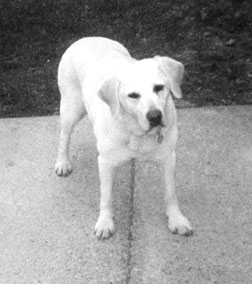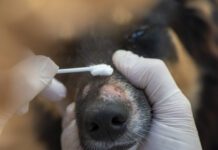by C. C. Holland
For Walt Cooper and his yellow Labrador Retriever, Sandy, a little sneezing turned into a big health problem. But by embracing a holistic approach that included both traditional veterinary medicine and a naturopathic element, Cooper has managed to extend his companion’s lease on life and keep her as happy and healthy as possible.

Walt Cooper, 60, a radio programmer living in Liverpool, New York, has shared his life with dogs for many years, but has a special affinity for yellow Labs. Sandy, his third yellow Lab, has been his beloved companion since late 1992, when he got her as a pup.
“She’s like talking to a human being,” says Cooper. “We’re very bonded. She has great enthusiasm.”
As a conscientious owner, Cooper was quick to notice when Sandy, then 10, began sneezing in June of 2003; occasionally, the discharge would have a bloody tinge. Instead of a simple foxtail or other foreign object in her nose, Cooper’s veterinarian discovered a mass in one of Sandy’s nasal cavities. The preliminary diagnosis was hemangioma, which is a benign lump formed by dilated small blood vessels in the skin. Although they’re not normally considered dangerous, Cooper agreed to a biopsy – just in case.
The pathology report came back with encouraging news, confirming the mass as benign. But Cooper had a gut feeling that he couldn’t ignore, and he decided to seek a second opinion for his beloved dog at the nearby Cornell University Hospital for Animals. “As we were getting this report, we thought we’d better get into Cornell just in case,” he says.
Cooper and Sandy made an appointment with Cornell’s oncology department, and agreed to a CT scan, blood tests, and additional biopsies. “They took 10 or 12 samples, and then we had a problem because (her left) eye became filled with blood because of the procedure,” says Cooper. “So she was in pretty bad shape at Cornell.”
Then came the kicker. The veterinarians at Cornell gave Cooper a revised diagnosis: Rather than a benign hemangioma, they said, Sandy was suffering from hemangioendo-thelioma – a rare type of cancer. Even worse, the CT scan revealed it was spreading into adjacent tissues.
“Hemangioendothelioma is an unusual diagnosis,” says Blaise Burke, DVM, a resident in radiation and medical oncology at Cornell’s veterinary hospital and Sandy’s primary clinician. “The most common types of tumors in dogs in the nasal cavity are adenocarcinomas. I don’t believe such a thing as hemangioendothelioma (in the nose) has ever been reported in the literature.”
Because of the proximity of the mass to Sandy’s eyes and brain and the fact that it was already spreading, attempting to excise the tumor wasn’t an option. Instead, Dr. Burke prescribed a course of radiation treatment – and he warned Cooper that Sandy’s future might be grim.
“This is a tumor with a rather poor prognosis, (with) a median survival time of around three months,” explains Dr. Burke. Cooper was told Sandy might have 8 to 12 weeks left to live at best.
Cooper agreed to let Sandy undergo radiation therapy in an effort to slow the spread of the tumor. However, after five of the six procedures were completed, he discontinued the treatment due to concern over some serious side effects.
“Her eye hemorrhaged, there were ulcers in her mouth . . . it was bad,” says Cooper. Sandy also developed conjunctivitis in response to the radiation. In the space of a couple of months, Sandy went from a happy, healthy dog to a cancer patient who was taking steroids, several types of antibiotic drugs, and painkillers.
Research begins
In an effort to help combat the effects of some of the drugs, Cooper began looking into some nutritional options. Sandy had already been on some basic supplements to help with her arthritis, including a glucosamine/chondroitin/MSM supplement, so Cooper wasn’t a stranger to the idea and knew where to start.
“I figured the first thing was to get good bacteria back into the body, because of the antibiotics, so I started with yogurt and cottage cheese,” he said. Then he stumbled across some information about turmeric (also known as curcumin), a spice used in many curries; some studies had found turmeric reduced tumor size. He figured, since the conventional veterinary treatment options for the cancer were nearly exhausted – additional rounds of radiation therapy were not recommended – why not try this? After checking things out thoroughly, he added turmeric to Sandy’s diet as well. Soon, Cooper became an avid researcher.
“I started talking to different people and reading different publications; I didn’t just go off and just do stuff (indiscriminately),” he said. “I would have to hear it in triplicate, from at least three sources, and also for canines, and make sure everything was right.”
Cooper looked up medical studies, read articles from journals and magazines (including WDJ), visited Web sites, and experimented with mixing different additives and supplements into Sandy’s diet. Her daily rations soon included things like flax seed oil, milk thistle extract, MSM, Ester-C, garlic, digestive enzymes, and a host of other supplements (see sidebar). Cooper’s goal: “To keep the immune system working as well as possible.”
Keeping Sandy happy
The approach appears to have paid off. “She’s lasted this long, we’ve been lucky,” says Cooper. “They said if she made it to Labor Day (2003), she’d be lucky.”
As of April 2004, Sandy is still battling eye problems and occasional nosebleeds, but she is active and happy. “She’s about 60 pounds, no fat, has a nice waistline, good teeth, her eyes are doing pretty good, and her appetite’s good,” says Cooper.
Walt maintains that a regular exercise regimen has also contributed to Sandy’s good spirits and thus, her robust immune system. “We play ball 10 minutes in the morning, 15 minutes at night, plus walking, so she stays in top physical shape,” he says. “Even when she was quite ill and feeling bad, a little ball-playing would perk her up, even if we were just rolling the ball for her a short distance in the house.”
Sandy’s veterinarians are also pleased with her condition.
“We’ve seen Sandy quite a bit, and we’ve all been really pleasantly surprised at how long she’s been going, given the kind of tumor and its location,” says Dr. Burke. “I think she’s looking pretty, she has good energy, good appetite, and her quality of life – in spite of her disease – is pretty good.”
On his own
Dr. Burke credits Sandy’s state of health, at least in part, to her radiation treatments. But he doesn’t know about Sandy’s steady diet of supplements, because Cooper hasn’t shared that information with him.
“I didn’t really think about it,” says Cooper, when asked why. “With most vets, if you tell them you’re using supplements, they’ll just say if it works, it works. Most vets I know don’t really mention anything alternative medicine all that often, unless they’re into that sort of thing.”
But wasn’t he concerned about possible interactions with her medical therapy? “When I started, given the seriousness of the diagnosis, they offered very little hope that she would live very long. And I just wanted to do anything I could to reduce the side effects of the medications she was on. Plus, it gave me something more that I could do for her. Honestly, I didn’t know that much about all of it when I started. But it was so successful – from the beginning, she did better than they predicted she would – that I got more and more into it, and started researching all sorts of things,” says Cooper. “I didn’t know that much when I started, but I sure know a lot now.”
As a general rule, it’s not a good idea to use herbs or an extensive supplement regimen without your veterinarian’s blessing, or at least his knowledge. Unless an owner is very knowledgeable about dosages, expected effects, possible side effects, potential drug interactions, the ways that the herbs or supplements can affect the drug dosages, etc., he could unwittingly cause a problem that neither he (nor the unsuspecting veterinarian) would be able to address appropriately.
This is where the assistance of a holistic veterinarian can be a huge asset. Many dog owners utilize the services of a conventional practitioner for emergency and/or primary care and diagnosis, and a holistic practitioner for advice about alternative or complementary treatments. At least one member of your dog’s healthcare “team” should be experienced and knowledgable about nutritional supplements and herbal treatments. (See “Coordinating Care,” WDJ May 2002.)
Walt researches the supplements and herbs he administers as well as the vet-prescribed drugs very thoroughly, watches his dog like a hawk, and feels confident that he could detect signs of a problem and take appropriate steps. Again, in most cases, if the dog’s primary care veterinarian uses only conventional medicine and is unsympathetic, uninterested, or even opposed to the use of adjunctive complementary therapies, an owner should consult with another veterinarian who is familiar with both the complementary and conventional regimes the dog will receive.
In Cooper’s case, extraordinary research was the name of the game. Cooper relies on scientific studies that he finds online, information from reputable publications and Web sites, and consultations with veterinary clinicians – and he warns anyone interested that it’s hard work.
“For anyone getting into this, you really have to read up on things,” he says. “Go to the Internet and download any (scientific study) abstracts you can get. Check everything out. I’d have to verify something two or three times before I’d give it to my dog, and then have to figure out the amount.”
Nothing better than vigilance
Another important part of Sandy’s success has been her owner’s unfailing ability to observe the slightest change in her condition or frame of mind. Cooper is quick to note any changes in Sandy’s demeanor and behavior and take action as soon as possible. For example, he recently discontinued many supplements – all the ones that can thin the blood – after she had some bloody discharge following sneezing. Also, he doesn’t hesitate to check in with his veterinarians, or whisk Sandy into the clinic if he sees anything awry.
Despite being unaware of the nutritional components of Sandy’s care, Dr. Burke recognizes that Cooper is the type of owner who’s willing to do anything it takes to improve his dog’s situation.
“Walt seems very diligent about watching her for any changes, and he will be quick to bring them to our attention,” says Dr. Burke. “I think his goals are to keep her comfortable and as happy as he can keep her for as long as possible. He’s really taken good care of her and it’s been a real pleasure to work with him.”
Beyond expectations
There’s no way of knowing the state of Sandy’s cancer without conducting another CT scan or chest X-rays, and Cooper has opted not to do that thus far, based both on expense and the fact that even if tests show the cancer has spread, there’s nothing more medically that can be done. But he is encouraged by the results he’s seen so far.
“Every time I’ve gotten to a roadblock and have exhausted everything I’ve read, somehow, somewhere, I either pick up an article or come up with something else that can help,” he says. “I call Sandy the comeback kid, because every time I think we’re at the end, something good happens.”
Holistic dog care means using everything at your disposal: attentive dog care, quick action, conventional veterinary medicine, high-tech innovations, alternative and complementary medicine where applicable, and sympathetic, sensitive nursing with the dog’s preferences and quality of life foremost in mind. We admit that this takes an extraordinary owner.
Walt Cooper embodies this description perfectly. But he brushes any such compliments off. “I’d do just about anything for this dog,” he says.
-C.C. Holland is a freelance writer in Oakland, California, and regular contributor to WDJ.





